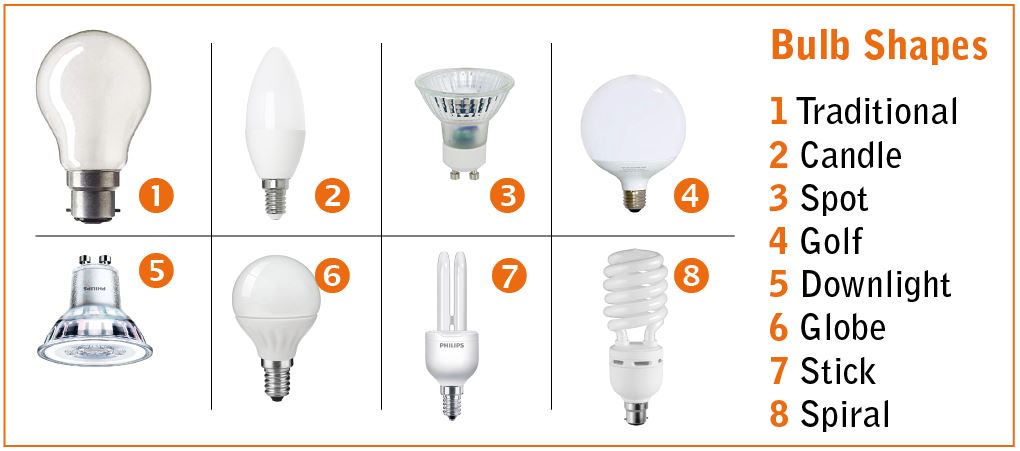Energy efficient lighting
Energy saving bulbs come in a range of shape, size and brightness. There are energy saving bulbs for most lighting needs and every type of fitting, including dimmable. What’s more, you can now choose to have a variety of colours of light to suit your taste.
There have been three generations of low-energy light bulbs: halogen bulbs, compact fluorescent light bulbs (CFLs) and light emitting diodes (LEDs). Each produce more light for every unit of electricity than their predecessor and each generation lasts for longer too.
Halogen bulbs
Halogen bulbs were phased out in 2021, though many homes will still have them. And while they are more efficient than old-style incandescent bulbs, this type of lighting uses a lot of electricity.
Rooms that are lit by halogens (typically kitchens) tend to have a lot of them so their total energy use can be quite high. In some cases, LEDs (see below) use just 10% of the power of halogens, so it might be worthwhile swapping them before the end of the halogen bulb’s natural life.
CFLs
Compact fluorescent light bulbs are often what people think of as a low energy bulb. They often look like tubes shaped into a helix or a series of loops, though it is possible to get CFLs in a range of traditional bulb shapes.
Early examples were criticised for poor light quality and for the length of time it took to get up to full brightness. Nowadays CFLs are much improved but have increasingly become a second-best option to LEDs.
LEDs
Light emitting diodes, usually referred to as LEDs, are the most efficient bulbs available. They achieve full brightness instantly, are available in almost all fittings and styles, are dimmable, and come in a wide range of colours, including hues close to traditional incandescent bulbs.
LEDs are more expensive than CFLs but their extremely low energy consumption means that they are likely to save you money – between £4 and £15 a year per bulb , depending on what kind of bulb you’re replacing. And they last about three times as long as CFLs.
Picking the right bulb
The choice available when buying new lightbulbs can be dizzying. Here’s a few steps to help you buy the right bulb:
Know the fitting and bulb shape
Bulbs come in a wide variety of fittings, such as screws, bayonets or pins. A good option is to take the old bulb shopping with you and compare it to the options available. You can also compare when shopping online, but be aware some fittings look the same but come in different sizes.

The shape of the bulb will affect how the light is distributed. Bulbs with a more traditional or candle shape offer an evenly distributed, diffuse light. Spotlights are more focussed. You don’t have to replace bulbs with one of the same shape; any bulb with the same fitting will work.

How bright do you want it?
Light bulbs are no longer rated in watts which was a measure of the amount of electricity it used and also of it’s brightness. But now brightness is measured in lumens, and this can be confusing as many people tended to know how bright a 60W or 100W bulb was but not how bright a 800 or 1600 lumen bulb is. Packaging will often state what the equivalent is, but this isn’t a completely reliable guide.
The table below shows the wattage you’d need to produce the same brightness with different types of bulbs. You can use it as a guide to converting your old bulbs to more energy efficient equivalents. For instance, you could replace your lighting with a 100 watt old-style bulb with a 20 watt LED bulb and get the same amount of light (using much less electricity).
| Lumens | Old-style | Halogen | CFL | LED |
| 1600 | 100W | 70W | 25W | 16W |
| 800 | 60W | 42W | 14W | 8W |
| 450 | 40W | 28W | 9W | 5W |
What colour?
One advantage of LED technology is the ability to produce a range of colours, which are measured in Kelvin (K). It is possible to buy LED’s that range from very warm (1,800K), with a strong orange look, to cool daylight (7000k), which has a stark bluey appearance. Warm white (2700k) is the most popular option and gives a similar light to an incandescent bulb.
Cool white (4000K) provides quite a bright and modern-looking light which is often popular in kitchens and bathrooms.
Turn them off!
Finally, if you’re worried about your electricity bill, a good thing to do is keep an eye out for lights that are on when they’re not needed, in hallways, landings and unoccupied rooms. And where you really do need to have a light on for long periods, make sure it’s the lowest wattage possible.




